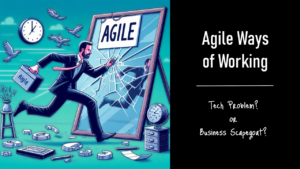As we approach Q4 of 2024, the agile methodology remains a hot topic in boardrooms, tech departments, and, dare I say, ‘water-cooler conversations’ everywhere. Yet, despite its nearly two-decade reign, there’s still a lingering question: Have businesses truly embraced agile for their benefit, or has it become the convenient scapegoat for organisational indecision?
The idea of agile—born from the need for flexibility, collaboration, and adaptability—remains, at its core, a simple one. Deliver value in increments, and adjust to change as it comes. However, what we’re seeing now is a bit of a misinterpretation. For some businesses, agile has evolved into a convenient license for executives to constantly change their minds, all while wondering why their teams aren’t delivering faster. Sound familiar?
The Misunderstanding of Agile’s True Purpose
One of the significant challenges in 2024’s agile landscape is not that businesses have failed to adopt agile practices, but rather that they’ve misunderstood what it’s supposed to achieve. The agile manifesto emphasises individuals and interactions over processes and tools, and responding to change over rigid planning. Yet, many executives have mistakenly taken these principles as carte blanche to frequently shift priorities, often at the expense of team cohesion and project completion.
I don’t believe the issue is agile itself but how it’s been wielded. Agile’s focus on change doesn’t mean constant churn. In fact, agile aims to manage and adapt to change—not be consumed by it. This misuse leads to frustration in teams that are left feeling like they’re playing a never-ending game of catch-up while the goalposts keep shifting. Meanwhile, stakeholders are left wondering why projects seem to be perpetually delayed. The answer often lies in the constant priority shifts rather than in the agile methodology itself.
Broken Processes? Blame Agile!
If there’s a universal truth to be found in 2024, it’s that technology can’t fix everything. It is not a Silver Bullet. Many organisations, in their rush to go agile, have overlooked one crucial element: their underlying business processes. You see, agile doesn’t fix broken processes, it exposes them. Yet, many companies have wrongly assumed that by adopting an agile framework, these foundational flaws will somehow disappear – or at the very least, enable them to continue being ignored, unclear, piecemeal and only fit-for-analog ways of working.
The reality is far more humbling. Agile thrives when it has a solid foundation to build upon—clear objectives, streamlined workflows, and collaborative cultures. Without these, agile will do little more than highlight the inefficiencies that were there all along. You can’t just throw technology at the problem and hope it sticks. Successful agile implementation requires an honest review of the holistic touch points within an organisation, from customer journeys to internal workflows and strategic levers to be pushed or pulled.
Tech: The Saviour or the Scapegoat?
Yet…here’s the kicker: Many business leaders seem to believe that adopting agile, along with a sprinkling of tech solutions, will solve every business problem they face. Need better project management? Let’s go agile. Want faster delivery? Surely, agile will handle that too. While agile is undoubtedly a powerful methodology, it’s not a panacea for every organisational woe.
2024 is showing us that businesses need to move away from viewing agile (and by extension, technology) as a magic wand. Instead, they need to take a more holistic approach, recognising that while agile can support faster and more flexible delivery, it won’t fix a broken business process, nor will it substitute for clear strategic direction.
Conclusion: Is Agile the Problem, or Are We?
So, where does this leave us? The real issue isn’t agile itself; it’s the way businesses have misinterpreted and misapplied it. Agile is, after all, a mindset — one that requires commitment not just to change, but to thoughtful, strategic change. It demands a willingness to adapt but also to maintain focus on the ultimate goal: delivering value to customers.
As we look ahead, businesses must resist the temptation to use agile as an excuse for poor planning, ill- or un-defined product requirements, or constant pivots. Instead, they should see it as a tool to enable clarity, foster collaboration, and—when used correctly—drive innovation. It’s time to stop blaming agile for the failures of broken processes and start seeing it as the powerful enabler it was always meant to be.
In short, if Agile isn’t working for you in 2024, maybe it’s time to ask: is it really Agile’s fault?
Contact us to discuss how we can help your project.
